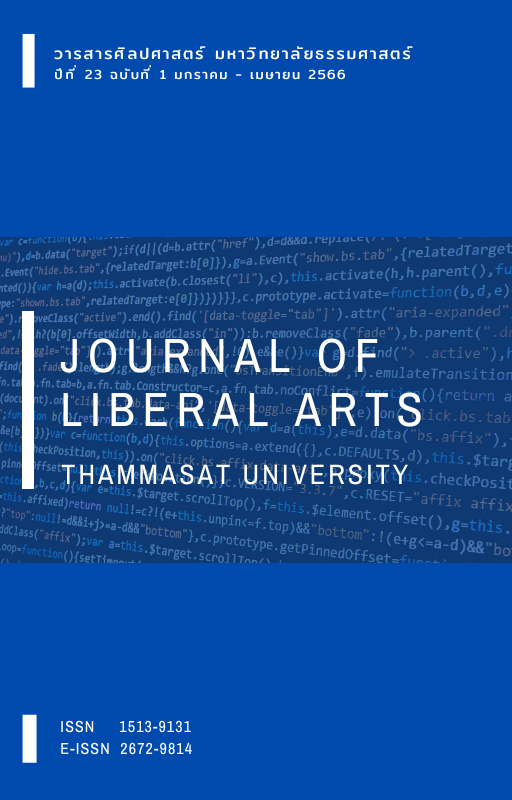กลวิธีแสดงความชัดเจนในการแปลวรรณกรรมเยาวชนภาษาญี่ปุ่นเป็นภาษาไทย : กรณีศึกษาการแปลคำแสดงบุคคล
Main Article Content
บทคัดย่อ
บทความนี้มีวัตถุประสงค์เพื่อศึกษากลวิธีแสดงความชัดเจนในการแปล ภาษาญี่ปุ่นเป็นภาษาไทย โดยวิเคราะห์ข้อมูลจากคำแสดงบุคคลในวรรณกรรมเยาวชน ผลการศึกษาพบการใช้กลวิธีแสดงความชัดเจนในสองกรณี คือ กรณีต้นฉบับไร้รูปแต่ในบทแปลมีการใช้รูปภาษา และกรณีต้นฉบับปรากฏรูปและผู้แปลใช้คำ (หรือสำนวน) ที่แสดงความหมายชัดเจนมากขึ้นว่าหมายถึงผู้ใด ซึ่งพบการแปลโดยใช้คำแสดงบุคคล 5 ชนิด ได้แก่ 1) คำสรรพนาม 2) คำแสดงความสัมพันธ์ 3) ชื่อเฉพาะ 4) คำนามทั่วไป 5) คำบ่งชี้ ทั้งนี้ ปัจจัยที่ส่งผลต่อการแปล อาจแบ่งเป็น ปัจจัยที่เกี่ยวข้องกับข้อบังคับทางภาษา และปัจจัยที่เกี่ยวข้องกับรสนิยมหรือสไตล์ของผู้แปล บริบท สังคมวัฒนธรรม ผลการวิจัยนี้น่าจะเป็นประโยชน์ต่อการศึกษาการแปลภาษาญี่ปุ่นเป็นไทยในอนาคต
Downloads
Article Details

อนุญาตภายใต้เงื่อนไข Creative Commons Attribution-NonCommercial-NoDerivatives 4.0 International License.
เอกสารอ้างอิง
กนกวรรณ เลาหบูรณะกิจ คะตะกิริ. (2565). มองภาษาญี่ปุ่นผ่านการเปรียบต่าง. โครงการเผยแพร่ผลงานวิชาการ คณะอักษรศาสตร์ จุฬาลงกรณ์มหาวิทยาลัย.
ปาริชาต ญาณวารี. (2544). กลวิธีการแปลวรรณกรรมเยาวชนของแมกไม้เรื่องชีลาร้ายที่สุดและน้องเล็กยังร้ายอยู่ [วิทยานิพนธ์ปริญญามหาบัณฑิต]. มหาวิทยาลัยมหิดล.
สมเกียรติ เชวงกิจวณิช. (2561). ปัญหาการแปลภาษาญี่ปุ่นเป็นภาษาไทย-การแปลคำศัพท์-. วารสารอักษรศาสตร์, 47(2), 271-330.
สมเกียรติ เชวงกิจวณิช. (2564). กลวิธีการแปลอนุพากย์จากภาษาญี่ปุ่นเป็นภาษาไทย. วารสารอักษรศาสตร์ มหาวิทยาลัยศิลปากร, 43(1), 70-88.
สุภนิช เนตรสุขแสง, และ ชลธิชา บำรุงรักษ์. (2562). การอ้างถึงบุคคลในนวนิยายภาษาไทยและนวนิยายภาษาอังกฤษ: กรณีศึกษา เรื่องความสุขของกะทิ 2562. ใน รายงานสืบเนื่อง จากการประชุมวิชาการ โครงการบัณฑิตศึกษาระดับชาติ สรรพศาสตร์ สรรพศิลป์ ประจำปี 2562 (น. 521-537). มหาวิทยาลัยธรรมศาสตร์.
สุปรียา วิลาวรรณ ธนะภูมิ. (2560). การแปลคำสันธาน “and” เป็นภาษาไทยและความเป็นสากลลักษณ์: กรณีศึกษา “Little House in the Big Woods” ของ Laura Ingalls Wilder. วารสารภาษาและภาษาศาสตร์, 35(2), 77-96.
สุวัธน์ เรืองศรี. (2561). การศึกษากลวิธีการแปลคำสรรพนามในวรรณกรรมญี่ปุ่นแปลไทย [วิทยานิพนธ์ปริญญามหาบัณฑิต]. มหาวิทยาลัยธรรมศาสตร์.
Baker, M. (1993). Corpus Linguistics and Translation Studies. Implications and Applications. In M. Baker, G. Francis, & E. Tognini-Bonelli (Eds.), Text and Technology: In Honour of John Sinclair (pp. 233-250). John Benjamins.
Blum-Kulka, S. (1986). Shifts of Cohesion and Coherence in Translation. In J. House, & S. Blum-Kulka (Eds.), Interlingual and Intercultural Communication: Discourse and Cognition in Translation and Second Language Acquistition Studies (pp. 17-35). Gunter Narr Verlag.
Chanawangsa, W. (1986). Cohesion in Thai [Doctoral Dissertation]. Georgetown University, Washington DC.
Fujinami, F. (2007). Honyaku-koi to Ibunkakan Communication: Kinoshugi-teki Honyaku-riron no Shoso [Translation acts and intercultural communication: Aspects of functional translation theory]. Shoraisha.
Fukusawa, M. (2019). Sanninsho Futsumeishi toshiteno Ninsho-daimeishi [On the Personal Pronoun as a 3rd- person Common Noun]. Bulletin of School of Japanese Studies Aichi Prefectural University, 10, 156-142.
Halliday, M. A. K., & Hasan, R. (1976). Cohesion in English. Longman.
Hanaoka, O. (2000). Hoso-tsuyaku ni okeru Meijika no Honyaku [Explicitation Strategies in News Interpreting]. Interpretation studies, 1, 69-85.
Hinds, J. (1986). Situation vs person focus. Kurosio.
Klaudy, K. (1998). Explicitation. In M. Baker, & G. Saldanha (Eds.), Routledge of encyclopedia translation studies (2nd ed., pp. 104-108). Routledge.
Kondo, Y. (2000). Nihongo Kijutsu-bunpo no Riron [Theory of Descriptive Grammar of Japanese]. Hituzi Syobo Publishing.
Langacker, R. W. (1985). Observations and speculations on subjectivity. In H. John (Ed.), Iconicity in Syntax (pp. 109-150). John Benjamins.
Liu, M. (2010). Corpus ni Miru Chu-nichi Honyaku ni okeru Meijika no Tokucho: Zasshi no Jiji-hodo-kiji wo Chushin ni [A Corpus-based Investigation into the feature of “Explicitation” in Journalistic Chinese - Japanese Translation]. Interpreting and Translation Studies, 10(0), 121-140.
Mikami, A. (1960). Zo wa Hana ga Nagai [Elephants have long trunks]. Kurosio.
Munday, J. (2008). Introducing Translation Studies (2nd ed.). Routledge.
Nguyen T. M., Van. (2018). Tsuyaku-Honyaku Process Model no Kento Sono Process ni okeru Meisekika Sutorategi wo Chushin ni -Vietnamgo Nihongo no Tsuyaku-Honyaku no Baai wo Jirei toshite- [A study on interpretation & translation process model: focusing on explicitation strategies in the process: from the study case of Vietnamese - Japanese interpretation & translation] [Doctoral Dissertation]. Tokyo University of Foreign Studies.
Øverås, L. (1998). In Search of the Third Code: An Investigation of Norms in Literary Translation. Meta, 43(4), 557-570.
Pym, A. (2005). Explaining explicitation. In K. Karoly, & A. Foris (Eds.), New Trends in Translation Studies: In Honour of Kinga Klaudy (pp. 29-34). Akadémia Kiadó.
Séguinot, C. (1988). Pragmatics and the explicitation hypothesis. TTR: traduction, terminologie, rédaction, 1(2), 106-114.
Siriacha, R., & Uehara S. (2019). Nit-taigo no Jishoshi Shiyo ni kansuru Corpus Bunseki [A Corpus Analysis of Self-Reference Terms in Japanese and Thai: Focusing on Types of Self-Reference Terms and Subjectivity]. Selected papers from the 43rd Meeting of Kansai Linguistic Society, 1, 135-146.
Sunakawa, Y. (1990). Shudai no Shoryaku to Hi-Shoryaku [Ellipsis and Non-ellipsis: A Case Study of Japanese Thematization]. Studies in language and literature. Language, 18, 15-30.
Vinay, J. -P., & Darbelnet, J. (1995). Comparative stylistics of French and English: a methodology for translation (Sager, J. C. & Hamel, M. - J., Trans.). John Benjamins. (Original work published 1958)


